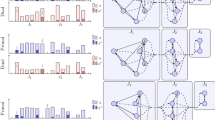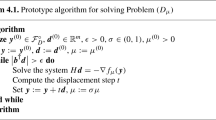Abstract
This paper describes a full-dimensional version of Karmarkar's linear programming algorithm, theprojective scaling algorithm, which is defined for any linear program in ℝn having a bounded, full-dimensional polytope of feasible solutions. If such a linear program hasm inequality constraints, then it is equivalent under an injective affine mappingJ:ℝn→ℝm to Karmarkar's original algorithm for a linear program in ℝm havingm—n equality constraints andm inequality constraints. Karmarkar's original algorithm minimizes a potential functiong(x), and the projective scaling algorithm is equivalent to that version of Karmarkar's algorithm whose step size minimizes the potential function in the step direction.
The projective scaling algorithm is shown to be a global Newton method for minimizing a logarithmic barrier function in a suitable coordinate system. The new coordinate system is obtained from the original coordinate system by a fixed projective transformationy = Ф(x) which maps the hyperplaneH opt ={x:〈c, x〉 =c 0} specified by the optimal value of the objective function to the “hyperplane at infinity”. The feasible solution set is mapped underФ to anunbounded polytope. Letf LB(y) denote the logarithmic barrier function associated to them inequality constraints in the new coordinate system. It coincides up to an additive constant with Karmarkar's potential function in the new coordinate system. Theglobal Newton method iterate y * for a strictly convex functionf(y) defined on a suitable convex domain is that pointy * that minimizesf(y) on the search ray {y+λ v N(y): λ≧0} wherev N(y) =−(∇2 f(y))−1(∇f(y)) is the Newton's method vector. If {x (k)} are a set of projective scaling algorithm iterates in the original coordinate system andy (k) =Ф(x (k)) then {y (k)} are a set of global Newton method iterates forf LB(y) and conversely.
Karmarkar's algorithm with step size chosen to minimize the potential function is known to converge at least at a linear rate. It is shown (by example) that this algorithm does not have a superlinear convergence rate.
Similar content being viewed by others
References
K. Anstreicher, “A monotonic projective algorithm for fractional linear programming,”Algorithmica 1 (1986) 483–498.
E. Barnes, “A variation on Karmarkar's algorithm for solving linear programming problems,”Mathematical Programming 36 (1986) 174–182.
D. Bayer and J.C. Lagarias, “The nonlinear geometry of linear programming I. Affine and projective scaling trajectories,”Transactions of the American Mathematical Society 314 (1989) 499–526.
D. Bayer and J.C. Lagarias, “The nonlinear geometry of linear programming II. Legendre transform coordinates and central trajectories,”Transactions of the American Mathematical Society 314 (1989) 527–581.
B. Bernstein, R.A. Toupin, “Some properties of the Hessian of a strictly convex function,”Journal für die reine und Angewandte Mathematik 210 (1962) 65–72.
J.W. Daniel,The Approximate Minimization of Functionals (Prentice-Hall, Englewood Cliffs, NJ, 1971).
W.C. Davidon, “Variable metric method for minimization,” AEC Research and Development Report ANL-5990 Rev., Argonne National Laboratory (Argonne, IL, 1959).
W.C. Davidon, “Conic approximations and collinear scalings for minimizers,”SIAM Journal on Numerical Analysis 17 (1980) 268–281.
J.F. Dennis, Jr. and J.J. Moré, “Quasi-Newton methods, motivation and theory,”SIAM Review 19 (1977) 46–89.
R.M. Freund, “An analog of Karmarkar's algorithm for inequality constrained linear programs, with a ‘new’ class of projective transformations for centering a polytope,”Operations Research Letters 7 (1988) 9–13.
P.E. Gill, W. Murray, M.A. Saunders, J.A. Tomlin and M.M. Wright, “‘On projected Newton barrier methods for linear programming and an equivalence to Karmarkar's projective method,”Mathematical Programming 36 (1986) 183–209.
K. Hoffman and R. Kunze,Linear Algebra (Prentice-Hall, Englewood Cliffs, NJ, 1963).
P. Huard, “Resolution of mathematical programming with nonlinear constraints by the method of centres,” in: J. Abadie, ed.,Nonlinear Programming (North-Holland, Amsterdam, 1967) pp. 209–219.
M. Iri and H. Imai, “A multiplicative barrier function method for linear programming,”Algorithmica 1 (1986) 455–482.
N. Karmarkar, “A new polynomial time algorithm for linear programming,”Combinatorica 2 (1984) 373–395.
J.C. Lagarias, “The nonlinear geometry of linear programming III, Projective Legendre transform coordinates and Hilbert geometry,”Transactions of the American Mathematical Society 320 (1990) 193–225.
J.C. Lagarias, “A collinear scaling interpretation of Karmarkar's algorithm,” in preparation.
J.M. Ortega and W.C. Rheinboldt,Iterative Solution of Nonlinear Equations in Several Variables (Academic Press, New York, 1970).
J. Renegar, “A polynomial-time algorithm, based on Newton's method, for linear programming,”Mathematical Programming 40 (1988) 59–94.
S. Smale, “A convergent process of price adjustment and global Newton methods,”Journal of Mathematical Economics 3 (1976) 107–120.
G. Sonnevend, “An ‘analytical centre’ for a polyhedron and new classes of global algorithms for linear (smooth, convex) programming,” in: A. Précopa, J. Szelsezán and B. Strazicky, eds.,System Modelling and Optimization, Proceedings of the 12th IFIP Conference, Lecture Notes in Control and Information Science No. 84 (Springer, New York, 1986).
G. Sonnevend, “A new method for solving a set of linear (convex) inequalities and its applications for identification and optimization,” in: B. Martos, ed.,Proceedings of the 5th IFAC-IFORS Conference, Budapest 1986 (Pergamon Press, Oxford, 1987).
G. Stolfi, “Oriented projective geometry (extended abstract),”Proceedings of the Third Annual ACM Symposium on Computational Geometry (ACM Press, New York, 1987) pp. 76–85.
P. Vaidya, “An algorithm for linear programming which requires O(((m+n)n 2+(m+n) 1.5 n)L) arithmetic operations,”Proceedings of the 19th Annual ACM Symposium on Theory of Computing (ACM Press, New York, 1987) pp. 29–38.
R.J. Vanderbei, M.J. Meketon and B.A. Freedman, “A modification of Karmarkar's linear programming algorithm,”Algorithmica 1 (1986) 395–407.
Author information
Authors and Affiliations
Rights and permissions
About this article
Cite this article
Bayer, D.A., Lagarias, J.C. Karmarkar's linear programming algorithm and Newton's method. Mathematical Programming 50, 291–330 (1991). https://doi.org/10.1007/BF01594941
Received:
Revised:
Issue Date:
DOI: https://doi.org/10.1007/BF01594941




